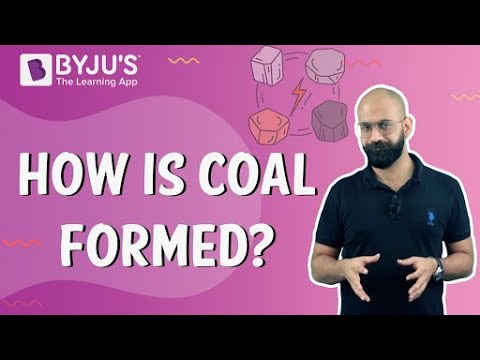What is Coal Gas?
Coal is one of the most useful fossil fuels. A mixture of gases obtained by the destructive distillation of coal and formerly used for lighting and heating.
It has many applications, some of which include the production of heat for households, firing of industrial generators, manufacturing of cast iron, etc. It can also be processed industrially in order to obtain products like coke, tar and coal gas. These by-products are beneficial to us too.
Table of Contents
- Coal Gas
- Recommended Videos
- Production of Coal Oil and Gas
- Coal Gas Composition
- Uses of Coal
- Coke and its Uses
- Coal Tar
- Frequently Asked Questions – FAQs
Coal Gas
Coal gas is also obtained as a by product while producing coke, and again, just like tar, its smell is not very pleasant. It is a highly flammable gas as the main component of it is methane. Thus, if not regulated carefully, it can form mixture with air resulting in explosions.
Production of Coal Oil and Gas
Plants and animals decompose to produce fossil fuels. These fuels, which can be found in the Earth’s crust and contain carbon and hydrogen, can be burned to generate energy. Fossil fuels include coal, oil, and natural gas, to name a few. Oil was discovered as a solid material between layers of sedimentary rock, such as shale, at first.
Fossil fuels include crude oil, coal, and natural gas. They were generated from the remains of deceased species over millions of years: coal was formed from dead trees and other plant debris. Dead sea organisms were used to create crude oil and gas. Petroleum is a fossil fuel that is also known as crude oil. Petroleum was generated from the remains of ancient sea organisms such as plants, algae, and bacteria, just as coal and natural gas.
Oil is a fossil fuel made up of a vast number of microscopic plants and animals such as algae and zooplankton. When these species die, they sink to the ocean’s bottom and become imprisoned under numerous layers of sand and mud.
Recommended Video

Coal Gas Composition
Coal gas, also known as a gaseous mixture, is a fuel made up of hydrogen, methane, and carbon monoxide produced by destructive distillation (continuous heating in the absence of air) of bituminous coal. Coal is mostly made up of carbon, with varying proportions of additional elements such as hydrogen, sulphur, oxygen, and nitrogen. Coal is generated when dead plant matter decays into peat, which is then transformed to coal over millions of years by the heat and pressure of deep burial.
Typical composition of the Coal gas is as follows:
- Hydrogen 50%
- Methane 35%
- Carbon monoxide 10%
- Ethylene 5%
Uses of Coal
- It is mainly used as a fuel in industries situated near coal processing plants.
- Earlier, it was used as a source of light. In the year 1820, it was used in London as street lighting.
- Now, it is more commonly used to provide heat for domestic and industrial purposes.
Coke and its Uses
Coke is a high-carbon product obtained by the destructive distillation of coal. The amount of carbon content in coke is so high that it is said to be an almost pure form of carbon. Coke is greyish-black in colour and is a hard, porous solid.
Uses of Coke:
- The most common use of coke is as a fuel for stoves, furnaces and blacksmithing. It is sometimes preferred over coal because burning coke produces very little smoke.
- It is also used to produce iron in a blast furnace.
- Coke is used to manufacture steel and many other materials.
Coal Tar
It is obtained as a by-product in the process of making coke. Though its colour is the same as coke, tar is a highly viscous liquid. It also has an extremely unpleasant smell. Uses:
- Coal tar is widely used to manufacture paints, perfumes, synthetic dyes, photographic material, drugs and explosives.
- It can be utilized to make insecticides and pesticides. Naphthalene balls that are commonly used to keep moths away are made from tar.
- Coal tar is an ingredient of anti-dandruff and lice-repelling shampoos, soaps and ointments.
Related Videos
Coal and Petroleum – Natural Resources

Coal and its Useful Products

Frequently Asked Questions – FAQs
Why is coal gas toxic?
Nitrogen in coal, like sulphur, reacts with oxygen in the air to generate nitrogen oxides. Nitrogen oxides can react with them to produce ozone and other contaminants. Humans, other animals, and plants are all at risk from these poisons.
What is coal made of?
Coal is a sedimentary rock that is black or brownish-black in colour and can be burned for fuel or used to create power. It is largely made up of carbon and hydrocarbons, both of which contain energy that can be released when burned (burning).
What is the difference between coal gas and natural gas?
Coal gas is a flammable gaseous fuel that is produced from coal and delivered to the end consumer. Natural gas is a fossil fuel that is used for heating, cooking, and generating electricity.
Which is the producer gas?
Producer gas is the product obtained when coal or coke is burnt with air deficiency and with a controlled amount of moisture. Producer gas is a gas mixture containing carbon monoxide hydrogen, carbon dioxide and nitrogen.
Is coal gas still used?
Coal gas is combustible and was used for heating and municipal lighting, before the advent of large-scale extraction of natural gas from oil wells. In current practice, large-scale coal gasification installations are primarily for electricity generation, or for production of chemical feedstocks.
To know more about this fossil fuel, its uses and its by-products and how they are produced commercially, download BYJU’S – The Learning App.


It is useful
Why is coke used for making perfume and medicine
Coal tar is used as a fixative in perfumes in order to make them evaporate slowly and emit their odour for relatively long durations of time. Coal tar can also be classified as a keratoplastic. It is known to cause the skin to shed dead cells on its surface.
Very helpful. Thank you so much!!
Define coal gas
Coal gas, gaseous mixture—mainly hydrogen, methane, and carbon monoxide—formed by the destructive distillation (i.e., heating in the absence of air) of bituminous coal and used as a fuel.
What are effects of coal products on the environment ?????
The burning of fossil fuels releases greenhouse gases into the atmosphere, increasing levels of CO2 and other gasses, trapping heat, and contributing to global climate change. Coal combustion releases the greenhouse gases carbon dioxide (CO2) and nitrous oxide (N2O) during combustion.
Define petroleum
Petroleum is a naturally occurring liquid found beneath the earth’s surface that can be refined into fuel. Petroleum is a fossil fuel, meaning that it has been created by the decomposition of organic matter over millions of years.
What are the sources and products of coal?
Ammonia gas recovered from coke ovens is used to manufacture ammonia salts, nitric acid and agricultural fertilisers. Thousands of different products have coal or coal by-products as components: soap, aspirins, solvents, dyes, plastics and fibres, such as rayon and nylon.